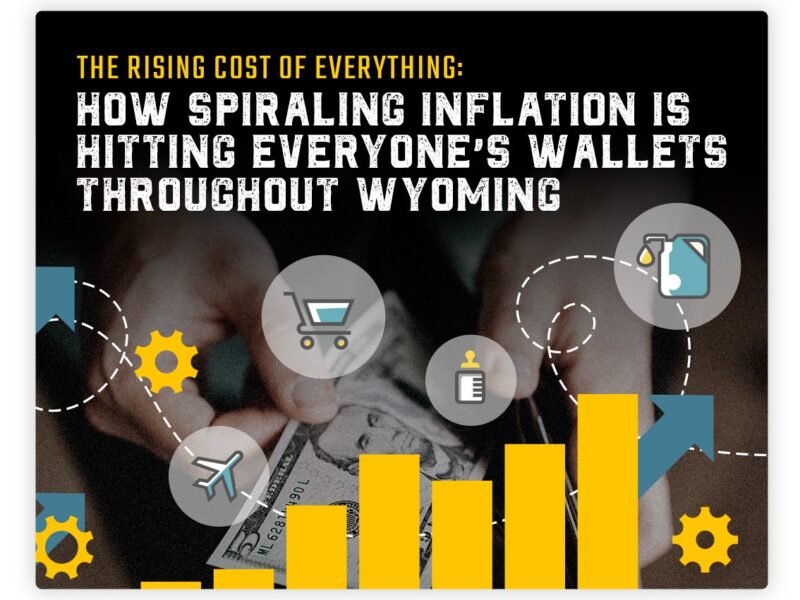THE RISING COST OF EVERYTHING: Demand Up for Contracting Company, But Profit Margins Down
Wheatland entrepreneur says inflated cost of supplies hurting customers and business
- Published In: Other News & Features
- Last Updated: Sep 05, 2022

By Shen Wu Tan
Special to the Wyoming Truth
Demand for contracting services has been better than ever for business owner K.C. Murphy—up 75% to 100% in the past two years—but it’s come with a heavy price tag. In these inflationary times, the cost of supplies is eroding his profit margins while putting a dent in his clients’ wallets.
“ . . . It’s been really hard to navigate what it means to manage a construction business in this day and age,” said Murphy, 34, co-owner of Capstone Industries, LLC.
And the Federal Reserve’s plan to hike interest rates even more could further impact his business.

“Higher interest rates could definitely mean less availability of funding to build projects for clients,” Murphy said.
The Wheatland-based contracting company has built homes, agriculture facilities and commercial buildings in Platte County and surrounding areas since 2014. Some of its recent projects include renovations to a local hospital, church and the Laramie County Community College.
A good goal for a construction company is to earn an 11% to 15% profit margin, but Capstone’s profit margins currently are below that, Murphy said.
The building industry in Wyoming has gained steam over the last two to three years, as more people moved to the state and demand for retirement and custom homes increased, he explained. Local businesses also have needed upgrades and facility maintenance.
Yet, as demand has gone up, so has the price of materials.
When Capstone opened, it cost about $150 to $175 per square foot to build a custom home. Now, that rate has nearly doubled to $275 to $325 per square foot, which means customers are essentially paying twice as much as they would have paid eight years ago.
“It makes it a lot harder for us to build their dream house, you know?” Murphy said.
The increase in material costs has had to be passed onto clients. Murphy noted that most contracting companies will add a markup margin for materials to cover incidentals such as screws, fasteners and glue.
“We’ve had to absorb those costs just to try and keep costs in the lower range for our clients,” Murphy said.
Capstone used to charge a 12% to 15% markup for incidentals, but is now charging 5% to relieve costs for its customers.
Another challenge the business owner faces: higher diesel prices. Capstone has six trucks and equipment that require diesel and need to be filled weekly. The company uses about 300 gallons of diesel per week and spends about $5.25 per gallon, up from $3 per gallon a year ago. That means Capstone shells out around $1,600 for diesel a week compared to $900 in 2021.
It also takes longer now to build a custom home—six or seven months due to material delays and availability, compared to three to four months before the supply chain crisis and economic downturn, said Murphy.
The contractor is dealing with a labor shortage and higher taxes, too. Last year, Capstone had a workforce of 16; today, it employs nine workers and is struggling to fill the empty slots. The tax rate for Murphy’s business also has also climbed about 8% in the past year—up from 28% to 36%, depending on profit margins, Murphy noted.
“This industry, the market industry, is a lot tougher to navigate now than what it would’ve been back in 2014 when we established the company,” he said. “We definitely have had to meet a lot of new challenges and a lot of new management tactics to make sure we can keep a business here . . .”
Among the new tactics: increasing efficiency; managing and training workers on properly cutting and using materials to decrease waste; and condensing building crews into a smaller number of trucks for transportation. If needed, Murphy said he and his wife, who co-owns Capstone, will take pay cuts to decrease expenses and avoid reducing employee pay.
“We kind of just have to take it as it comes,” Murphy said. “Overall, I’m pretty optimistic about the industry and what we do, because I know that God will continue to source us . . . We can view it as life happens to us or we can view it as life happens for us.”













